Chapter 01
Limits, Alternatives, and Choices
Multiple Choice Questions
1. Economics is the study of:
A. increasing the level of productive resources so there is maximum output in society.
B. increasing the level of productive resources so there is a minimum level of income.
C. how people, institutions, and society make choices under conditions of scarcity.
D. the efficient use of scarce resources paid for at the minimum level of cost to consumers and businesses.
2. The primary focus of the study of economics is with:
A. expanding the production of goods and services.
B. equalizing the distribution of consumer income and wealth.
C. making the most efficient use of scarce productive resources.
D. reallocating resources from consumption to production in the economy.
3. The general concern of economics is with the study of the:
A. degree of competition in stock and bond markets in the economy.
B. efficient use of limited productive resources to satisfy economic wants.
C. issue of equality in the distribution of income and wealth among households.
D. budget deficits in the domestic economy and trade deficits in the international economy.
4. Which of the following is not a central focus of the "economic perspective"?
A. Scarcity and choice.
B. The scientific method.
C. Purposeful behavior.
D. Marginal analysis.
5. The term scarcity in economics refers to the fact that:
A. economic wants are limited and resources are abused.
B. even in the richest country some people go hungry.
C. no country can produce enough products to satisfy everybody's economic wants.
D. it is impossible to produce too much of any particular good or service in a market economy.
6. The basic economic problem is essentially one of deciding how to make the best use of:
A. limited resources to satisfy limited economic wants.
B. limited resources to satisfy unlimited economic wants.
C. unlimited resources to satisfy unlimited economic wants.
D. unlimited resources to satisfy limited economic wants.
7. The key economic concept that serves as the basis for the study of economics is:
A. inflation.
B. unemployment.
C. money.
D. scarcity.
8. As a student of economics, when you speak of scarcity, you are referring to the ability of society to:
A. employ all of its resources.
B. consume all that is produced.
C. satisfy economic wants given limited resources.
D. continually make technological breakthroughs and increase production.
9. As a consequence of the condition of scarcity:
A. there is never enough of anything.
B. production has to be centrally planned.
C. things which are plentiful have relatively high prices.
D. individuals and communities have to make choices from among alternatives.
10. What is the economic meaning of the expression that "there is no such thing as a free lunch"?
A. It refers to "free-riders," who do not pay for the cost of a product, but who receive the benefit from it.
B. It means that economic freedom is limited by the amount of income available to the consumer.
C. It means that there is an opportunity cost when resources are used to provide "free" products.
D. It indicates that products only have value because people are willing to pay for them.
11. According to the Gates, Winfrey, and Rodriguez illustration:
A. Gates, Winfrey, and Rodriguez made a mistake by not attending college.
B. Gates, Winfrey, and Rodriguez did not weigh marginal benefits against marginal costs when making decisions.
C. Opportunity costs vary greatly between individuals and matter in decision-making.
D. Attending college has little effect on lifetime earnings.
12. One major feature of the economic perspective is:
A. that scarcity is more important than choice.
B. that costs are more important than benefits.
C. the assumption of purposeful behavior by individuals.
D. the recognition of economic resources in the economy.
13. The satisfaction or pleasure one gets from consuming a good or service is:
A. price.
B. utility.
C. consumption.
D. preferences.
14. The utility of a specific product:
A. is determined by consumer income.
B. is determined by the price of the product.
C. varies from person to person using the product.
D. is constant from person to person using the product.
15. Which expression is another way of saying "marginal cost"?
A. total cost
B. additional cost
C. rational behavior
D. scarcity
16. Henry wants to buy a book. The economic perspective suggests that Henry will buy the book if:
A. the book will give him utility.
B. his income is high.
C. the marginal cost of the book is greater than its marginal benefit.
D. the marginal benefit of the book is greater than its marginal cost.
17. From an economic perspective, when a consumer decides to buy more life insurance, the consumer has most likely concluded that the:
A. marginal costs of more insurance coverage have decreased.
B. marginal benefits of more insurance coverage have increased.
C. marginal benefits of more insurance coverage are greater than the marginal costs.
D. opportunity costs of more insurance coverage are greater than the payment for more insurance coverage.
18. From an economic perspective, when a student decides to attend another year of college, the student has concluded that the marginal:
A. costs of attending college has decreased that year.
B. benefits of attending college has increased that year.
C. benefits of attending college are greater than the marginal costs.
D. costs of attending college will be subsidized by someone else such as parents or the government.
19. When an economist says that there is "too much of a good thing," the economist is suggesting that:
A. scarcity is not a problem.
B. wants are not unlimited.
C. the marginal cost of the thing is less than the marginal benefit.
D. the marginal benefit of the thing is less than the marginal cost.
20. The concept of "purposeful behavior" suggests that:
A. macroeconomics is more important then microeconomics.
B. microeconomics is more important than macroeconomics.
C. people make different choices because their circumstances and information differ.
D. there is a logical fallacy of composition that affects microeconomic thinking but not macroeconomic thinking.
21. Are the goods that businesses offer for "free" to consumers also free to society?
A. Yes, because the individual consumer does not have to pay for them.
B. Yes, because the marginal benefit is greater than the marginal cost.
C. No, because scarce resources were used to produce the free goods.
D. No, because society does not assign a value to free goods.
22. When producers maximize their profits from the production of a good or service, they are:
A. testing a hypothesis.
B. exhibiting purposeful behavior.
C. assuming that all other things are equal.
D. making a tradeoff between economic efficiency and economic freedom.
23. How is the economic perspective reflected in lines for fast food?
A. Customers select the shortest line because they have perfect information.
B. Customers select the shortest line because they believe it will reduce their time cost of obtaining food.
C. Lines will typically be of unequal length because of the inefficiencies in counter service.
D. The set of food choices is often too complex for most customers and thus creates long lines.
24. From an economic perspective, when consumers leave a fast-food restaurant because the lines to be served are too long, they have concluded that the:
A. marginal cost of waiting is less than the marginal benefit of being served.
B. marginal cost of waiting is greater than the marginal benefit of being served.
C. management is exhibiting irrational behavior by not maximizing profits.
D. management is making an assumption that other things are equal.
25. The process of developing hypotheses, testing them against facts, and using the results to construct theories is called:
A. opportunity cost calculation.
B. the scientific method.
C. marginal analysis.
D. microeconomics.
26. The statement that "the unemployment rate will increase as the economy moves into a recession" is an example of:
A. a normative statement.
B. a microeconomic statement.
C. marginal analysis.
D. a generalization.
27. An economic model is:
A. a value judgment.
B. a fact.
C. built using theory.
D. built on policies.
28. Economic models do not reflect the full complexity of reality and instead are based on:
A. tradeoffs.
B. purposeful simplifications.
C. value judgments.
D. the fallacy of composition.
29. The role of an assumption in an economic theory is to:
A. add realism.
B. prove the theory.
C. cover special cases.
D. simplify the theory.
30. The purpose of the ceteris paribus assumption used in economic analysis is to:
A. make sure that all relevant factors are considered.
B. avoid making normative statements.
C. aggregate economic data.
D. restrict the analysis to the effect of a single economic factor.
31. A basic assumption used in most economic theories is that:
A. what is true for a part of the whole must also be true for the whole.
B. as price decreases, quantity demanded will increase.
C. whatever goes up must come down.
D. all other things remain the same.
32. Economists have difficulty applying the scientific method because:
A. economic conditions are constant.
B. controlled laboratory experiments are impossible or often infeasible.
C. people are involved, and their behavior is entirely predictable.
D. the scientific method does not apply to economics.
33. Which question is an illustration of a macroeconomic question?
A. What is the amount of profit for Intel and other makers of microchips?
B. How does a cut in the business tax rate increase business investment in the economy?
C. What will be the level of stock market and bond market prices at the end of the year?
D. How does the supply of fruits and vegetables change when there is bad weather affecting crops?
34. Which is an illustration of a microeconomic question?
A. What is the current national rate of unemployment?
B. Is the economy experiencing a decline in the rate of inflation?
C. Will a new type of television set increase the number of buyers?
D. Is the production of goods and services in the economy greater this year than last year?
35. Which question is an example of a microeconomic question?
A. What should the Federal government do to reduce the trade deficit with Japan?
B. Will the merger of two airlines likely lead to higher airline ticket prices?
C. What factors are contributing to the rise of unemployment in the economy?
D. Will the inflation rate remain relatively stable this year?
36. Microeconomics focuses on:
A. the workings of the whole economy or large sectors of it.
B. the individual units that make up the whole of the economy.
C. issues such as unemployment and inflation.
D. total output and the general level of prices.
37. Macroeconomics focuses on:
A. the individual units that make up the whole of the economy.
B. studies of how individual markets and industries are organized.
C. total output and the general level of prices in the economy.
D. how a business determines how much of a product to produce.
38. The study of how one business firm sets its prices would fall under the study of:
A. macroeconomics.
B. microeconomics.
C. income distribution.
D. economic growth.
39. The branch of economics that focuses primarily on aggregates is:
A. macroeconomics.
B. microeconomics.
C. scientific economics.
D. consumer economics.
40. An "aggregate:"
A. treats a collection of specific units as one unit.
B. treats a single unit as if it were a set or collection of specific units
C. is the primary unit of analysis in microeconomics.
D. is too large to analyze using standard macroeconomic theories.
41. Which would be considered a macroeconomic study? A study of the effect of:
A. a decrease in the price of automobiles on automobile sales.
B. government spending to increase employment.
C. a new tax on the profits of a business.
D. interest rates on a firm's investment.
42. Which question is an illustration of a microeconomic question?
A. Is the quantity of wine purchased in one year dependent upon the price of wine?
B. Does government spending influence the total level of employment in the economy?
C. Is the purchasing power of the dollar higher or lower today than it was in 2000?
D. Is capitalism superior to socialism?
43. Which question is an illustration of a macroeconomic question?
A. Is a business unresponsive to the demands of consumers?
B. Is a consumer boycott an effective means of reducing product prices?
C. Is the level of employment in the economy sensitive to the quantity of consumer spending?
D. Are oil companies engaging in a rip-off of the consumer by charging exorbitantly high prices for gasoline?
44. The macroeconomist would most likely study:
A. the effects of changing beer prices on the market for pretzels.
B. the effects of an increased income tax on a typical household's purchase of goods.
C. the effects of a reduction in income tax rates on the nation's total output.
D. how consumers in Gary, Indiana, respond to a reduction in gasoline prices.
45. Macroeconomics is the study of economics from the standpoint of:
A. individual economic units.
B. a typical firm.
C. a typical household.
D. the overall economy.
46. The alternative combinations of two goods which a consumer can purchase with a given money income is:
A. a production possibilities curve.
B. a demand curve.
C. consumer equilibrium.
D. a budget line.
47. The price ratio of the two products is the:
A. marginal rate of substitution.
B. slope of the budget line.
C. point of tangency for equilibrium.
D. demand for the two products.
48. Decreases in the price of a product causes the consumer's:
A. production possibilities curves to shift outward from the origin.
B. production possibilities curves to shift inward to the origin.
C. budget line to shift outward from the origin.
D. budget line to shift inward to the origin.
49. Assume that money income decreases and the prices of products X and Y both decrease, then the budget line:
A. must shift outward from the origin.
B. must shift inward to the origin.
C. may shift either outward from or inward to the origin.
D. will no longer be in equilibrium.
50. Suppose a consumer has an income of $16, the price of A is $2, and the price of B is $1. Which combination is on the consumer's budget line?
A. 4A and 9B
B. 5A and 6B
C. 6A and 6B
D. 8A and 8B
51. If a consumer has an income of $200, the price of X is $5, and the price of Y is $10, the maximum quantity of X the consumer is able to purchase is:
A. 5.
B. 10.
C. 20.
D. 40.
52. Assume that a consumer purchases two products and there is an increase in the consumer's money income. All other things equal, the most likely effect is:
A. an outward shift in the production possibilities curve because the consumer can now satisfy more wants.
B. an inward shift in the budget line because the consumer can now purchase less of both products.
C. an outward shift in the budget line because the consumer can now purchase more of both products.
D. no change in the equilibrium of the consumer.
Answer the next question(s) using the following figure:
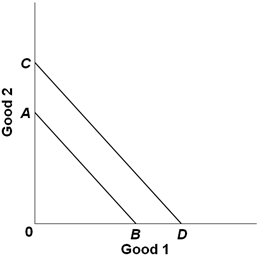
53. Refer to the above graph. The shift of the budget line from AB to CD is consistent with:
A. a decrease in money income.
B. an increase in money income.
C. an increase in the price of Good 1.
D. a decrease in the price of Good 2.
54. Refer to the above graph. The shift of the budget line from CD to AB is consistent with:
A. a decrease in money income.
B. an increase in money income.
C. an increase in the price of Good 1.
D. a decrease in the price of Good 2.
55. In the diagram above, Cheri's budget line shifts outward from AB to CD. Which statement below is consistent with this shift?
A. Both prices double; her income doubles.
B. Her income is reduced; no change in either price.
C. Both prices are reduced by 50 percent; her income is reduced by less than 50 percent.
D. Both the price of good 1 and Cheri's income increase; there is no change in price for good 2.
Answer the next question(s) using the following figure:
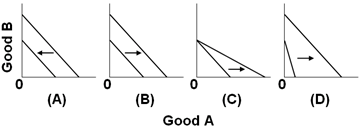
56. Refer to the above graph. Which pairs of budget constraints represent only an increase in income, but no change in the price of A and B?
A. graph A
B. graph B
C. graph C
D. graph D
57. Refer to the above graph. Which pairs of budget constraints represent only a decrease in the price of Good A, but no change in income?
A. graph A
B. graph B
C. graph C
D. graph D
Answer the next question using the following figure:
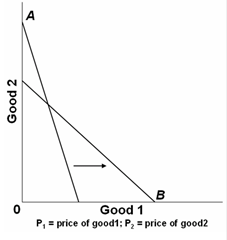
58. In the graph above, A is the initial budget line and B is the new budget line. Which of the following changes might have occurred?
A. P1 was unchanged, P2 increased, income decreased
B. P1 decreased, P2 increased, income was unchanged
C. P1 increased, P2 decreased, income was unchanged
D. P1 decreased, P2 was unchanged, income increased
Answer the next question(s) using the following figures:
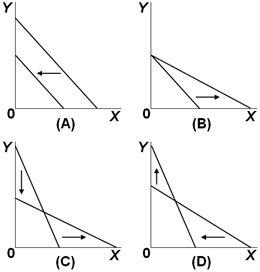
59. Refer to the above graph. Which pairs of budget constraints represent only a decrease in income, but no change in the price of X and Y?
A. graph A
B. graph B
C. graph C
D. graph D
60. Refer to the above graph. Which pairs of budget constraints represent only a decrease in the price of X, but no change in income and no change in the price of Y?
A. graph A
B. graph B
C. graph C
D. graph D
61. Refer to the above graphs. Which of the above budget constraint lines illustrates a decrease in the price of good X and an increase in the price of good Y?
A. graph A
B. graph B
C. graph C
D. graph D
Answer the next question using the following figures:
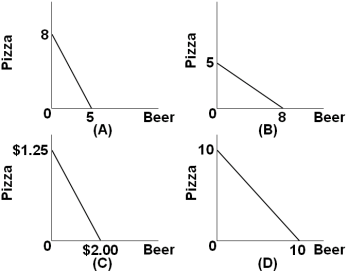
62. Refer to the above graphs. Pizza and beer are the only two goods Jon consumes. The price of beer is $2.00 per pitcher and pizza is $1.25 per slice. If Jon has only $10 to spend for the evening, which graph represents the set of possible combinations of beer and pizza he can consume?
A. graph A
B. graph B
C. graph C
D. graph D
63. The individual who brings together economic resources and assumes the risk in a capitalist economy is called the:
A. manager.
B. entrepreneur.
C. stockbroker.
D. banker.
64. Which would not be considered as capital (or an economic resource) by an economist?
A. a share of corporate stock issued by General Motors
B. an automobile used by General Electric
C. a crane used by a building contractor
D. a razor used by a barber
65. Which is not considered to be an economic resource?
A. land (or natural resources)
B. money
C. labor
D. tools and machinery
66. Economic resources in the capitalist system are brought together by:
A. government units.
B. entrepreneurs.
C. corporate shareholders.
D. the managerial elite.
67. Money is not considered to be an economic resource because:
A. as such it is not productive.
B. money is not a free gift of nature.
C. the terms of trade can be determined in nonmonetary terms.
D. idle money balances do not earn interest income.
68. Which is a factor of production?
A. money
B. interest
C. rent
D. capital
69. Which is considered to be an economic resource by economists?
A. rent
B. money
C. labor
D. wages
70. Society wants to use its scarce resources efficiently. To achieve this economic goal it must:
A. have full employment and full production.
B. have a fixed resource base and fixed technology.
C. expand the use of capital goods and reduce the use of labor.
D. increase the rental, interest, wage, and profit payments to the factors of production.
71. When an economy is at full employment and full production, more of any one product:
A. cannot be produced because there is full production.
B. can be produced only if there is a general decrease in prices.
C. can be produced only if there is less production of some other products.
D. cannot be produced unless private enterprise does so rather than government.
72. The production possibilities curve represents which of the following?
A. the amount of goods attainable with variable resources
B. the maximum amount of goods attainable with variable resources
C. maximum combinations of goods attainable with fixed resources
D. the amount of goods attainable if prices decline
73. On a production possibilities curve, the single optimal or best combination of output for any society:
A. is at a point near the top of the curve.
B. is at the precise midpoint of the curve.
C. is at a point near the bottom of the curve.
D. depends upon the preferences of society.
Use the table to complete the following question(s).
The following economy produces two products.

74. Refer to the above table. The total opportunity cost of the three units of steel is:
A. 15 units of wheat.
B. 20 units of wheat.
C. 45 units of wheat.
D. 55 units of wheat.
75. Refer to the above table. The marginal opportunity cost of the third unit of steel is:
A. 10 units of wheat.
B. 15 units of wheat.
C. 20 units of wheat.
D. 30 units of wheat.
76. Refer to the above table. A change from possibility C to B means that:
A. 1 unit of steel is given up to get 75 units of wheat.
B. 2 units of steel are given up to get 75 units of wheat.
C. 1 unit of steel is given up to get 15 more units of wheat.
D. 2 units of steel are given up to get 15 more units of wheat.
77. Refer to the above table. In moving from possibility A to F, the cost of a unit of steel in terms of a unit of wheat:
A. increases.
B. decreases.
C. remains constant.
D. increases from A to B, and decreases from B to F.
Use the table to complete the following question(s).
The following economy produces two products.

78. Refer to the above table. The total opportunity cost of the three units of tanks is:
A. 200 units of autos.
B. 350 units of autos.
C. 650 units of autos.
D. 1000 units of autos.
79. Refer to the above table. The marginal opportunity cost of the fourth unit of tanks is:
A. 200.
B. 300.
C. 350.
D. 650.
80. Refer to the above table. The opportunity cost of each additional tank in terms of autos:
A. remains constant.
B. falls as more tanks are produced.
C. increases as more tanks are produced.
D. cannot be measured because there is no currency.
81. Refer to the above table. According to the production possibilities schedule, a combination of four tanks and 650 autos is:
A. attainable, but involves an efficient use of society's resources.
B. attainable, but would not be in the best interests of a strong national defense.
C. not attainable because it is not listed in the schedule.
D. not attainable because society does not have sufficient resources to produce this combination.
82. Given the production possibilities schedule above, a combination of three tanks and 350 autos:
A. illustrates the tradeoff between tanks and autos.
B. is attainable but involves the unemployment or inefficient use of some of society's resources.
C. cannot be produced by society, given its current
D. Level of resources and production technology.
E. is not attainable because this combination is not listed in the schedule.
Use the graph below to complete the following question(s).
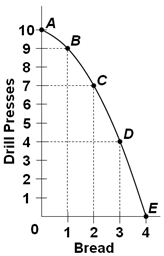
83. Refer to the above graph. The total opportunity cost of nine drill presses is:
A. 1 unit of bread.
B. 2 units of bread.
C. 3 units of bread.
D. 4 units of bread.
84. Refer to the above graph. The marginal opportunity cost of the fourth unit of bread is:
A. 1 unit of drill presses.
B. 2 units of drill presses.
C. 3 units of drill presses.
D. 4 units of drill presses.
85. A point inside the production possibilities curve is:
A. attainable and the economy is efficient.
B. attainable, but the economy is inefficient.
C. unattainable, but the economy is inefficient.
D. unattainable and the economy is efficient.
86. A point on the frontier of the production possibilities curve is:
A. attainable and the economy is efficient.
B. attainable, but the economy is inefficient.
C. unattainable, but the economy is inefficient.
D. unattainable and the economy is efficient.
87. The production possibility curve:
A. is convex to the origin.
B. is based on the law of diminishing returns.
C. is the boundary between attainable and unattainable outputs.
D. reflects the mixed economy found with most economic systems.
88. A movement along the production possibilities curve would imply that:
A. the labor force has grown.
B. productivity has increased.
C. productivity has declined.
D. society has chosen a different set of outputs.
89. If an economy is producing at a point inside a production possibilities curve:
A. the economy is efficient.
B. there is economic growth.
C. resources are unemployed.
D. resources are fully employed.
Use the graph below to complete the following question.
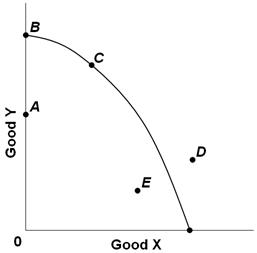
90. The graph above shows the production possibilities curve for an economy producing two goods, X and Y. Which of the points on the graph indicate unemployed resources?
A. D only
B. E only
C. E and A only
D. B and C only
91. If an economy that produces capital and consumer goods is operating at a point on its production possibilities curve, this indicates that:
A. it is achieving full employment but not full production.
B. it is achieving full production but not full employment.
C. more capital goods can be produced only at the cost of some consumer goods.
D. the economy is incapable of achieving significant economic growth.
92. Consider a society that is producing inside its production possibilities frontier. This society could best achieve efficiency in its production of output by:
A. distributing incomes more equally.
B. fully employing all available resources.
C. increasing the levels of wages and prices.
D. producing relatively more capital goods and relatively fewer consumer goods.
93. A reduction in the level of unemployment would have which effect with respect to the nation's production possibilities curve?
A. It would shift the curve to the right.
B. It would shift the curve to the left.
C. It would not shift the curve; it would be represented by moving from a point inside the curve toward the curve.
D. It would not shift the curve; it would be represented by moving from a point on the curve to a point to the right of the curve.
Use the graph below to complete the following question(s).
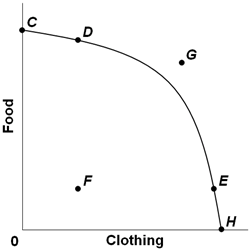
94. Points C, D, E, and H on the above graph show:
A. an inefficient allocation of society's scarce resources.
B. a constant tradeoff between food and clothing.
C. possible combinations of food and clothing.
D. unattainable combinations of food and clothing.
95. The combination of food and clothing shown by point G on the above graph:
A. is not attainable, given society's available resources and technology.
B. can be attained only if some of society's resources are unemployed.
C. suggests that the law of increasing relative costs is not relevant in this case.
D. results only because society allocates its resources inefficiently.
96. Along a production possibilities curve, an increase in the production of one type of good can be accomplished only by:
A. decreasing the production of the other type of good.
B. increasing the production of the other type of good.
C. holding constant the production of the other type of good.
D. decreasing the price of the other type of good.
97. Assume that for Indy, one hour of study time in economics is perfectly substitutable for an hour of study time in calculus. Indy has exams in both subjects tomorrow and he determines that if spends all of his time studying economics, he will receive scores of 96 on his economics exam and 45 on his calculus exam. If he studies only calculus, his econ score will be 81 and his calculus score 90. Based on this information and assuming that Indy has no better alternative use of his time, what is the opportunity cost of improving his econ score by one (1) point?
A. 1 point on his calculus exam.
B. 1/3 point on his calculus exam.
C. 3 points on his calculus exam.
D. The opportunity cost cannot be determined with the information given.
98. If a production possibilities boundary is a concave curve and not a straight line, then:
A. resources are equally suited to producing alternative products.
B. resources are not equally suited to producing alternative products.
C. resources are perfectly interchangeable to alternative uses.
D. there are unemployed resources.
99. If economic resources are perfectly shiftable between the two products shown on a production possibilities graph:
A. the economy will always be at full employment.
B. more of one product can be produced without producing less of the other product.
C. the production possibilities curve would be a straight line.
D. the two products are of equal value to the economy.
100. The production possibilities curve bows outward from the origin because:
A. opportunity costs decrease as the production of a good increases.
B. opportunity costs increase as the production of a good increases.
C. more production of one good results in more production of the other good.
D. resources are of uniform quality.
101. The law of increasing opportunity costs indicates that:
A. resources are perfectly mobile except for transportation costs.
B. the sum of all costs cannot rise above the market price of a product.
C. to produce more of one good, society must sacrifice larger and larger amounts of alternative goods.
D. if the prices of all the resources involved in the production of goods increase, the cost of producing those goods will increase at the same rate.
Use the table below to complete the following questions.
The production possibilities curve below shows the hypothetical relationship between the production of capital goods and consumer goods in an economy.

102. Refer to the table above. What is the opportunity cost of producing the third unit of capital goods?
A. 4 units of consumer goods
B. 5 units of consumer goods
C. 6 units of consumer goods
D. 7 units of consumer goods
103. Refer to the table above. What is the opportunity cost of producing the first two units of capital goods?
A. 4 units of consumer goods
B. 5 units of consumer goods
C. 9 units of consumer goods
D. 13 units of consumer goods
104. Refer to the table above. What is the opportunity cost of producing the first three units of capital goods?
A. 6 units of consumer goods
B. 7 units of consumer goods
C. 15 units of consumer goods
D. 22 units of consumer goods
105. The law of increasing opportunity cost explains why the shape of the production possibilities curve is:
A. a straight line parallel to the horizontal axis.
B. a straight line from one axis to the other.
C. bowed out from the origin of the graph.
D. bowed toward the origin of the graph.
106. Which statement is an economic rationale for the law of increasing opportunity cost?
A. The economy is employing all of its available resources.
B. Many economic resources are better at producing one product than another.
C. In any economy, the state of technology is changing and resources are variable.
D. The economy is achieving productive efficiency by producing goods and services at the least cost.
107. Opportunity cost is best defined as:
A. marginal cost minus marginal benefit.
B. the value of the best foregone alternative.
C. the time spent on an economic activity.
D. the money cost of an economic decision.
108. Tammie makes $150 a day as a bank clerk. She takes off two days of work without pay to fly to another city to attend the concert of her favorite music group. The cost of transportation for the trip is $250. The cost of the concert ticket is $50. The opportunity cost of Tammie's trip to the concert is:
A. $300.
B. $450.
C. $500.
D. $600.
109. When a state government chooses to build more roads, the required resources are no longer available for spending on public education. This dilemma illustrates the concept of:
A. marginal analysis.
B. full employment.
C. full production.
D. opportunity cost.
110. The opportunity cost of a new national park is the:
A. alternative uses for the land and funding for the park.
B. cost of constructing park buildings and highways to get to it.
C. cost of hiring staff and park rangers to provide services for visitors.
D. increased pollution to the wildlife habitat at the park.
111. After graduating from high school, Ron Willis plans to go to college. The college tuition is $15,000 a year. But, instead of going to college, Ron could take a full-time job paying $20,000. If Ron decides to go to college, what is his opportunity cost for attending for one year?
A. $5,000
B. $15,000
C. $20,000
D. $35,000
112. In a production possibilities table, the most-valued or optimal point for society is determined by:
A. a combination of products at the midpoint of the table.
B. a combination of products at the ends of the table.
C. the equality of marginal benefits and marginal costs.
D. the maximization of opportunity costs.
113. The overallocation of resources by society to the production of a product means that the:
A. marginal benefit is greater than the marginal cost.
B. marginal cost is greater than the marginal benefit.
C. entrepreneurs are making too much profit in the economy.
D. workers are not being paid adequate wages and salaries.
114. When society overallocates resources to the production of a product it means that the:
A. investment in the product is declining.
B. opportunity cost of the product is decreasing.
C. marginal benefit is greater than the marginal cost.
D. marginal benefit is less than the marginal cost.
115. The "war on terror" waged by the United States:
A. Shifted the production possibilities curve to the right.
B. Shifted the production possibilities curve inward.
C. Caused the U.S. to shift from "defense goods" to "civilian goods."
D. Caused the perceived marginal benefit curve for "defense goods" to shift out.
116. Scaling back the U.S. "war on terror" would:
A. Shift U.S. production from "defense goods" to "civilian goods."
B. Shift U.S. production from "civilian goods" to "defense goods."
C. Shift the production possibilities curve inward.
D. Suggest that we were allocating less than the optimal amount of resources to the war on terror.
117. Economic growth may be represented by a:
A. rightward shift of the production possibilities curve.
B. leftward shift of the production possibilities curve.
C. production possibilities curve which remains fixed.
D. point outside (to the right) of the production possibilities curve.
118. Increases in resources or improvements in technology will tend to cause a society's production possibilities curve to:
A. shift inward or to the left.
B. shift outward or to the right.
C. become horizontal.
D. become vertical.
119. A nation that devotes more of its resources to capital investment is likely to:
A. shift outward its production possibilities curve.
B. shift inward its production possibilities curve.
C. increase the slope of its production possibilities curve.
D. decrease the slope of its production possibilities curve.
120. All of the following would affect the position of a country's production possibilities curve, except:
A. the quantity of labor.
B. the level of unemployment.
C. the amount of the capital stock.
D. technological progress.
Use the graph below to answer the following question(s).
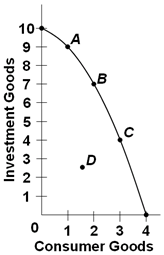
121. Refer to the above graph. Which point on the production possibilities curve would indicate that there is unemployment in this economy?
A. A
B. B
C. C
D. D
122. Refer to the above graph. The selection of which point on the production possibilities curve is most like to result in the largest increase in economic growth over time?
A. A
B. B
C. C
D. D
Use the graph below to answer the following question.

123. The graph above shows two production possibilities curves for a nation which produces two goods, Y and Z. PP1 and PP2 show the production possibilities for years 1 and 2. The nation's total production then decreased after year 2. This change could be represented by a move from:
A. F to A.
B. A to E.
C. F to B.
D. E to D.
Use the graph below to answer the following question(s).
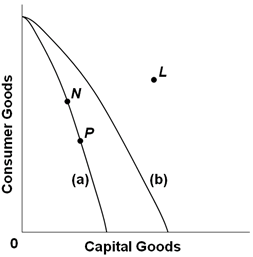
124. Refer to the above production possibilities curves. Curve (a) is the current curve for the economy. Given production possibilities curve (a), point N suggests that the economy is:
A. attaining full employment but not full production.
B. attaining full production but not full employment.
C. using its available resources inefficiently.
D. attaining both full employment and full production.
125. Refer to the above production possibilities curves. Curve (a) is the current curve for the economy. The movement from curve (a) to curve (b) suggests:
A. a movement from unemployment to full employment.
B. an improvement in capital goods technology but not in consumer goods technology.
C. an improvement in consumer goods technology but not in capital goods technology.
D. a decline in the total output of this society.
126. Refer to the above production possibilities curves. Curve (a) is the current curve for the economy. Other things being equal, society's current choice of point P on curve (a) will:
A. allow it to achieve more rapid economic growth than would the choice of point N.
B. entail a slower rate of economic growth than would the choice of point N.
C. entail the same rate of growth as would the choice of point N.
D. be unobtainable because it exceeds the productive capacity of the economy.
127. Which situation would most likely shift the production possibilities curve for a nation in an outward direction?
A. a decrease in the quality of products
B. an increase in the supply of resources
C. a decrease in the state of technology
D. an increase in the amount of discrimination
128. Suppose there are two economies, Alpha and Beta, which have the same production possibilities curves and are on the same point on each curve. If Beta then devotes more resources to investment goods than consumer goods when compared to Alpha, then in the future:
A. Alpha will experience greater economic growth than Beta.
B. Beta will experience greater economic growth than Alpha.
C. Alpha will not be able to achieve full employment or productive efficiency.
D. Beta will not be able to achieve full employment or productive efficiency
129. Cuba is a command economy that suffered decline in economic growth because of a cut in support from the former Soviet Union when it collapsed. As a consequence, Cuba:
A. experienced a shift outward in its production possibilities curve.
B. experienced a shift inward in its production possibilities curve.
C. moved along its existing production possibilities curve.
D. went to a point inside its production possibilities curve.
130. Which situation would most likely cause a nation's production possibilities curve to shift inward?
A. the construction of more capital goods
B. an increase in discrimination based on race
C. an increase in the number of skilled immigrant workers
D. the destruction from bombing and warfare in a losing military conflict
131. A nation can increase its production possibilities by:
A. shifting resources from investment good production to consumer good production.
B. shifting resources from private goods to public goods.
C. improving labor productivity.
D. eliminating discrimination.
Use the graph below to answer the following question.
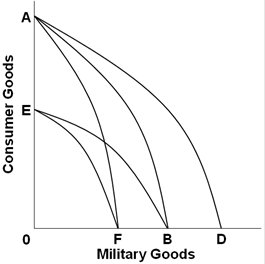
132. Refer to the above graph. Assume that before the Persian Gulf War, Iraq's production possibilities were represented by AB. Which line on the above graph would represent the change in Iraq's production possibilities after the war?
A. AB to BE
B. AB to AF
C. AB to AD
D. AB to EF
True / False Questions
133. Economics is the study of the efficient use of scarce resources to achieve maximum satisfaction of economic wants.
True False
134. Marginal analysis is the comparison of additional benefits with the additional costs.
True False
135. From the "economic perspective" people make purposeful decisions based on hypotheses.
True False
136. Economics is primarily concerned with marginal changes from the status quo.
True False
137. The scientific method involves developing hypotheses from factual observations, and then testing the hypotheses.
True False
138. By using the same ceteris paribus assumptions, economic principles are just as certain and precise as those of the laboratory sciences.
True False
139. Macroeconomics is concerned with the whole economy or its major sectors.
True False
140. The economizing problem arises from the conflict between having relatively unlimited resources and relatively limited wants.
True False
141. The fundamental economic problem is that productive resources are scarce in relation to the demand for them.
True False
142. The four factors of production are land, labor, capital, and government services.
True False
143. A point inside the production possibilities curve illustrates that resources are not being used as efficiently as possible.
True False
144. The concave, or bowed-out, shape of the production possibilities curve illustrates the law of increasing opportunity costs.
True False
145. If the marginal benefits are greater than the marginal cost of an activity, then society is overallocating resources to this activity.
True False
146. The marginal cost curve for a product slopes upward as more units are produced because of the law of increasing costs.
True False
147. If the marginal benefits of the output from resources devoted to the production of a product are greater than the marginal costs, then there has been an overallocation of resources to the production of that product.
True False
148. Economic growth is shown by a shift of the production possibilities curve outward and to the right.
True False
149. If a nation is incurring a trade deficit (it is buying more from abroad - importing, then it is selling abroad - exporting), then it is most likely producing beyond the frontier of its production possibilities curve.
True False
150. The implied production possibilities curve between work time and grades suggests that more hours spent working will mean more income, but also less study time and a lower grade average.
True False
Chapter 01 Limits, Alternatives, and Choices Answer Key
Multiple Choice Questions
1. Economics is the study of:
A. increasing the level of productive resources so there is maximum output in society.
B. increasing the level of productive resources so there is a minimum level of income.
C. how people, institutions, and society make choices under conditions of scarcity.
D. the efficient use of scarce resources paid for at the minimum level of cost to consumers and businesses.
AACSB: Analytic
Bloom's: Knowledge
Learning Objective: 1-1
Level: Easy
Topic: Economics; economic perspectives
2. The primary focus of the study of economics is with:
A. expanding the production of goods and services.
B. equalizing the distribution of consumer income and wealth.
C. making the most efficient use of scarce productive resources.
D. reallocating resources from consumption to production in the economy.
AACSB: Analytic
Bloom's: Knowledge
Learning Objective: 1-1
Level: Easy
Topic: Economics; economic perspectives
3. The general concern of economics is with the study of the:
A. degree of competition in stock and bond markets in the economy.
B. efficient use of limited productive resources to satisfy economic wants.
C. issue of equality in the distribution of income and wealth among households.
D. budget deficits in the domestic economy and trade deficits in the international economy.
AACSB: Analytic
Bloom's: Knowledge
Learning Objective: 1-1
Level: Easy
Topic: Economics; economic perspectives
4. Which of the following is not a central focus of the "economic perspective"?
A. Scarcity and choice.
B. The scientific method.
C. Purposeful behavior.
D. Marginal analysis.
AACSB: Analytic
Bloom's: Knowledge
Learning Objective: 1-1
Level: Moderate
Topic: Economics; economic perspectives
5. The term scarcity in economics refers to the fact that:
A. economic wants are limited and resources are abused.
B. even in the richest country some people go hungry.
C. no country can produce enough products to satisfy everybody's economic wants.
D. it is impossible to produce too much of any particular good or service in a market economy.
AACSB: Analytic
Bloom's: Knowledge
Learning Objective: 1-1
Level: Easy
Topic: Economics; economic perspectives
6. The basic economic problem is essentially one of deciding how to make the best use of:
A. limited resources to satisfy limited economic wants.
B. limited resources to satisfy unlimited economic wants.
C. unlimited resources to satisfy unlimited economic wants.
D. unlimited resources to satisfy limited economic wants.
AACSB: Analytic
Bloom's: Knowledge
Learning Objective: 1-1
Level: Easy
Topic: Economics; economic perspectives
7. The key economic concept that serves as the basis for the study of economics is:
A. inflation.
B. unemployment.
C. money.
D. scarcity.
AACSB: Analytic
Bloom's: Knowledge
Learning Objective: 1-1
Level: Difficult
Topic: Economics; economic perspectives
8. As a student of economics, when you speak of scarcity, you are referring to the ability of society to:
A. employ all of its resources.
B. consume all that is produced.
C. satisfy economic wants given limited resources.
D. continually make technological breakthroughs and increase production.
AACSB: Analytic
Bloom's: Knowledge
Learning Objective: 1-1
Level: Moderate
Topic: Economics; economic perspectives
9. As a consequence of the condition of scarcity:
A. there is never enough of anything.
B. production has to be centrally planned.
C. things which are plentiful have relatively high prices.
D. individuals and communities have to make choices from among alternatives.
AACSB: Analytic
Bloom's: Knowledge
Learning Objective: 1-1
Level: Easy
Topic: Economics; economic perspectives
10. What is the economic meaning of the expression that "there is no such thing as a free lunch"?
A. It refers to "free-riders," who do not pay for the cost of a product, but who receive the benefit from it.
B. It means that economic freedom is limited by the amount of income available to the consumer.
C. It means that there is an opportunity cost when resources are used to provide "free" products.
D. It indicates that products only have value because people are willing to pay for them.
AACSB: Reflective
Bloom's: Application
Learning Objective: 1-1
Level: Moderate
Topic: Economics; economic perspectives
11. According to the Gates, Winfrey, and Rodriguez illustration:
A. Gates, Winfrey, and Rodriguez made a mistake by not attending college.
B. Gates, Winfrey, and Rodriguez did not weigh marginal benefits against marginal costs when making decisions.
C. Opportunity costs vary greatly between individuals and matter in decision-making.
D. Attending college has little effect on lifetime earnings.
AACSB: Analytic
Bloom's: Knowledge
Learning Objective: 1-1
Level: Easy
Topic: Economics; economic perspectives
12. One major feature of the economic perspective is:
A. that scarcity is more important than choice.
B. that costs are more important than benefits.
C. the assumption of purposeful behavior by individuals.
D. the recognition of economic resources in the economy.
AACSB: Analytic
Bloom's: Knowledge
Learning Objective: 1-1
Level: Easy
Topic: Economics; economic perspectives
13. The satisfaction or pleasure one gets from consuming a good or service is:
A. price.
B. utility.
C. consumption.
D. preferences.
AACSB: Analytic
Bloom's: Knowledge
Learning Objective: 1-1
Level: Easy
Topic: Economics; economic perspectives
14. The utility of a specific product:
A. is determined by consumer income.
B. is determined by the price of the product.
C. varies from person to person using the product.
D. is constant from person to person using the product.
AACSB: Analytic
Bloom's: Knowledge
Learning Objective: 1-1
Level: Moderate
Topic: Economics; economic perspectives
15. Which expression is another way of saying "marginal cost"?
A. total cost
B. additional cost
C. rational behavior
D. scarcity
AACSB: Analytic
Bloom's: Knowledge
Learning Objective: 1-1
Level: Easy
Topic: Economics; economic perspectives
16. Henry wants to buy a book. The economic perspective suggests that Henry will buy the book if:
A. the book will give him utility.
B. his income is high.
C. the marginal cost of the book is greater than its marginal benefit.
D. the marginal benefit of the book is greater than its marginal cost.
AACSB: Analytic
Bloom's: Application
Learning Objective: 1-1
Level: Moderate
Topic: Economics; economic perspectives
17. From an economic perspective, when a consumer decides to buy more life insurance, the consumer has most likely concluded that the:
A. marginal costs of more insurance coverage have decreased.
B. marginal benefits of more insurance coverage have increased.
C. marginal benefits of more insurance coverage are greater than the marginal costs.
D. opportunity costs of more insurance coverage are greater than the payment for more insurance coverage.
AACSB: Analytic
Bloom's: Knowledge
Learning Objective: 1-1
Level: Easy
Topic: Economics; economic perspectives
18. From an economic perspective, when a student decides to attend another year of college, the student has concluded that the marginal:
A. costs of attending college has decreased that year.
B. benefits of attending college has increased that year.
C. benefits of attending college are greater than the marginal costs.
D. costs of attending college will be subsidized by someone else such as parents or the government.
AACSB: Analytic
Bloom's: Knowledge
Learning Objective: 1-1
Level: Moderate
Topic: Economics; economic perspectives
19. When an economist says that there is "too much of a good thing," the economist is suggesting that:
A. scarcity is not a problem.
B. wants are not unlimited.
C. the marginal cost of the thing is less than the marginal benefit.
D. the marginal benefit of the thing is less than the marginal cost.
AACSB: Analytic
Bloom's: Knowledge
Learning Objective: 1-1
Level: Easy
Topic: Economics; economic perspectives
20. The concept of "purposeful behavior" suggests that:
A. macroeconomics is more important then microeconomics.
B. microeconomics is more important than macroeconomics.
C. people make different choices because their circumstances and information differ.
D. there is a logical fallacy of composition that affects microeconomic thinking but not macroeconomic thinking.
AACSB: Analytic
Bloom's: Knowledge
Learning Objective: 1-1
Level: Moderate
Topic: Economics; economic perspectives
21. Are the goods that businesses offer for "free" to consumers also free to society?
A. Yes, because the individual consumer does not have to pay for them.
B. Yes, because the marginal benefit is greater than the marginal cost.
C. No, because scarce resources were used to produce the free goods.
D. No, because society does not assign a value to free goods.
AACSB: Analytic
Bloom's: Knowledge
Learning Objective: 1-1
Level: Moderate
Topic: Economics; economic perspectives
22. When producers maximize their profits from the production of a good or service, they are:
A. testing a hypothesis.
B. exhibiting purposeful behavior.
C. assuming that all other things are equal.
D. making a tradeoff between economic efficiency and economic freedom.
AACSB: Analytic
Bloom's: Knowledge
Learning Objective: 1-1
Level: Easy
Topic: Economics; economic perspectives
23. How is the economic perspective reflected in lines for fast food?
A. Customers select the shortest line because they have perfect information.
B. Customers select the shortest line because they believe it will reduce their time cost of obtaining food.
C. Lines will typically be of unequal length because of the inefficiencies in counter service.
D. The set of food choices is often too complex for most customers and thus creates long lines.
AACSB: Analytic
Bloom's: Knowledge
Learning Objective: 1-1
Level: Moderate
Topic: Economics; economic perspectives
24. From an economic perspective, when consumers leave a fast-food restaurant because the lines to be served are too long, they have concluded that the:
A. marginal cost of waiting is less than the marginal benefit of being served.
B. marginal cost of waiting is greater than the marginal benefit of being served.
C. management is exhibiting irrational behavior by not maximizing profits.
D. management is making an assumption that other things are equal.
AACSB: Analytic
Bloom's: Knowledge
Learning Objective: 1-1
Level: Moderate
Topic: Economics; economic perspectives
25. The process of developing hypotheses, testing them against facts, and using the results to construct theories is called:
A. opportunity cost calculation.
B. the scientific method.
C. marginal analysis.
D. microeconomics.
AACSB: Analytic
Bloom's: Knowledge
Learning Objective: 1-2
Level: Easy
Topic: Theories, principles, and models
26. The statement that "the unemployment rate will increase as the economy moves into a recession" is an example of:
A. a normative statement.
B. a microeconomic statement.
C. marginal analysis.
D. a generalization.
AACSB: Analytic
Bloom's: Knowledge
Learning Objective: 1-2
Level: Easy
Topic: Theories, principles, and models
27. An economic model is:
A. a value judgment.
B. a fact.
C. built using theory.
D. built on policies.
AACSB: Analytic
Bloom's: Knowledge
Learning Objective: 1-2
Level: Easy
Topic: Theories, principles, and models
28. Economic models do not reflect the full complexity of reality and instead are based on:
A. tradeoffs.
B. purposeful simplifications.
C. value judgments.
D. the fallacy of composition.
AACSB: Analytic
Bloom's: Knowledge
Learning Objective: 1-2
Level: Easy
Topic: Theories, principles, and models
29. The role of an assumption in an economic theory is to:
A. add realism.
B. prove the theory.
C. cover special cases.
D. simplify the theory.
AACSB: Analytic
Bloom's: Knowledge
Learning Objective: 1-2
Level: Easy
Topic: Theories, principles, and models
30. The purpose of the ceteris paribus assumption used in economic analysis is to:
A. make sure that all relevant factors are considered.
B. avoid making normative statements.
C. aggregate economic data.
D. restrict the analysis to the effect of a single economic factor.
AACSB: Analytic
Bloom's: Knowledge
Learning Objective: 1-2
Level: Difficult
Topic: Theories, principles, and models
31. A basic assumption used in most economic theories is that:
A. what is true for a part of the whole must also be true for the whole.
B. as price decreases, quantity demanded will increase.
C. whatever goes up must come down.
D. all other things remain the same.
AACSB: Analytic
Bloom's: Knowledge
Learning Objective: 1-2
Level: Easy
Topic: Theories, principles, and models
32. Economists have difficulty applying the scientific method because:
A. economic conditions are constant.
B. controlled laboratory experiments are impossible or often infeasible.
C. people are involved, and their behavior is entirely predictable.
D. the scientific method does not apply to economics.
AACSB: Analytic
Bloom's: Knowledge
Learning Objective: 1-2
Level: Easy
Topic: Theories, principles, and models
33. Which question is an illustration of a macroeconomic question?
A. What is the amount of profit for Intel and other makers of microchips?
B. How does a cut in the business tax rate increase business investment in the economy?
C. What will be the level of stock market and bond market prices at the end of the year?
D. How does the supply of fruits and vegetables change when there is bad weather affecting crops?
AACSB: Analytic
Bloom's: Knowledge
Learning Objective: 1-3
Level: Moderate
Topic: Macroeconomics and microeconomics
34. Which is an illustration of a microeconomic question?
A. What is the current national rate of unemployment?
B. Is the economy experiencing a decline in the rate of inflation?
C. Will a new type of television set increase the number of buyers?
D. Is the production of goods and services in the economy greater this year than last year?
AACSB: Analytic
Bloom's: Application
Learning Objective: 1-3
Level: Easy
Topic: Macroeconomics and microeconomics
35. Which question is an example of a microeconomic question?
A. What should the Federal government do to reduce the trade deficit with Japan?
B. Will the merger of two airlines likely lead to higher airline ticket prices?
C. What factors are contributing to the rise of unemployment in the economy?
D. Will the inflation rate remain relatively stable this year?
AACSB: Analytic
Bloom's: Application
Learning Objective: 1-3
Level: Moderate
Topic: Macroeconomics and microeconomics
36. Microeconomics focuses on:
A. the workings of the whole economy or large sectors of it.
B. the individual units that make up the whole of the economy.
C. issues such as unemployment and inflation.
D. total output and the general level of prices.
AACSB: Analytic
Bloom's: Knowledge
Learning Objective: 1-3
Level: Moderate
Topic: Macroeconomics and microeconomics
37. Macroeconomics focuses on:
A. the individual units that make up the whole of the economy.
B. studies of how individual markets and industries are organized.
C. total output and the general level of prices in the economy.
D. how a business determines how much of a product to produce.
AACSB: Analytic
Bloom's: Knowledge
Learning Objective: 1-3
Level: Easy
Topic: Macroeconomics and microeconomics
38. The study of how one business firm sets its prices would fall under the study of:
A. macroeconomics.
B. microeconomics.
C. income distribution.
D. economic growth.
AACSB: Analytic
Bloom's: Knowledge
Learning Objective: 1-3
Level: Easy
Topic: Macroeconomics and microeconomics
39. The branch of economics that focuses primarily on aggregates is:
A. macroeconomics.
B. microeconomics.
C. scientific economics.
D. consumer economics.
AACSB: Analytic
Bloom's: Knowledge
Learning Objective: 1-3
Level: Easy
Topic: Macroeconomics and microeconomics
40. An "aggregate:"
A. treats a collection of specific units as one unit.
B. treats a single unit as if it were a set or collection of specific units
C. is the primary unit of analysis in microeconomics.
D. is too large to analyze using standard macroeconomic theories.
AACSB: Analytic
Bloom's: Knowledge
Learning Objective: 1-3
Level: Easy
Topic: Macroeconomics and microeconomics
41. Which would be considered a macroeconomic study? A study of the effect of:
A. a decrease in the price of automobiles on automobile sales.
B. government spending to increase employment.
C. a new tax on the profits of a business.
D. interest rates on a firm's investment.
AACSB: Analytic
Bloom's: Knowledge
Learning Objective: 1-3
Level: Moderate
Topic: Macroeconomics and microeconomics
42. Which question is an illustration of a microeconomic question?
A. Is the quantity of wine purchased in one year dependent upon the price of wine?
B. Does government spending influence the total level of employment in the economy?
C. Is the purchasing power of the dollar higher or lower today than it was in 2000?
D. Is capitalism superior to socialism?
AACSB: Analytic
Bloom's: Knowledge
Learning Objective: 1-3
Level: Difficult
Topic: Macroeconomics and microeconomics
43. Which question is an illustration of a macroeconomic question?
A. Is a business unresponsive to the demands of consumers?
B. Is a consumer boycott an effective means of reducing product prices?
C. Is the level of employment in the economy sensitive to the quantity of consumer spending?
D. Are oil companies engaging in a rip-off of the consumer by charging exorbitantly high prices for gasoline?
AACSB: Analytic
Bloom's: Knowledge
Learning Objective: 1-3
Level: Difficult
Topic: Macroeconomics and microeconomics
44. The macroeconomist would most likely study:
A. the effects of changing beer prices on the market for pretzels.
B. the effects of an increased income tax on a typical household's purchase of goods.
C. the effects of a reduction in income tax rates on the nation's total output.
D. how consumers in Gary, Indiana, respond to a reduction in gasoline prices.
AACSB: Analytic
Bloom's: Knowledge
Learning Objective: 1-3
Level: Moderate
Topic: Macroeconomics and microeconomics
45. Macroeconomics is the study of economics from the standpoint of:
A. individual economic units.
B. a typical firm.
C. a typical household.
D. the overall economy.
AACSB: Analytic
Bloom's: Knowledge
Learning Objective: 1-3
Level: Easy
Topic: Macroeconomics and microeconomics
46. The alternative combinations of two goods which a consumer can purchase with a given money income is:
A. a production possibilities curve.
B. a demand curve.
C. consumer equilibrium.
D. a budget line.
AACSB: Analytic
Bloom's: Knowledge
Learning Objective: 1-4
Level: Moderate
Topic: Individual's economic problem
47. The price ratio of the two products is the:
A. marginal rate of substitution.
B. slope of the budget line.
C. point of tangency for equilibrium.
D. demand for the two products.
AACSB: Analytic
Bloom's: Knowledge
Learning Objective: 1-4
Level: Moderate
Topic: Individual's economic problem
48. Decreases in the price of a product causes the consumer's:
A. production possibilities curves to shift outward from the origin.
B. production possibilities curves to shift inward to the origin.
C. budget line to shift outward from the origin.
D. budget line to shift inward to the origin.
AACSB: Analytic
Bloom's: Knowledge
Learning Objective: 1-4
Level: Easy
Topic: Individual's economic problem
49. Assume that money income decreases and the prices of products X and Y both decrease, then the budget line:
A. must shift outward from the origin.
B. must shift inward to the origin.
C. may shift either outward from or inward to the origin.
D. will no longer be in equilibrium.
AACSB: Analytic
Bloom's: Knowledge
Learning Objective: 1-4
Level: Moderate
Topic: Individual's economic problem
50. Suppose a consumer has an income of $16, the price of A is $2, and the price of B is $1. Which combination is on the consumer's budget line?
A. 4A and 9B
B. 5A and 6B
C. 6A and 6B
D. 8A and 8B
AACSB: Analytic
Bloom's: Application
Learning Objective: 1-4
Level: Moderate
Topic: Individual's economic problem
51. If a consumer has an income of $200, the price of X is $5, and the price of Y is $10, the maximum quantity of X the consumer is able to purchase is:
A. 5.
B. 10.
C. 20.
D. 40.
AACSB: Analytic
Bloom's: Application
Learning Objective: 1-4
Level: Moderate
Topic: Individual's economic problem
52. Assume that a consumer purchases two products and there is an increase in the consumer's money income. All other things equal, the most likely effect is:
A. an outward shift in the production possibilities curve because the consumer can now satisfy more wants.
B. an inward shift in the budget line because the consumer can now purchase less of both products.
C. an outward shift in the budget line because the consumer can now purchase more of both products.
D. no change in the equilibrium of the consumer.
AACSB: Analytic
Bloom's: Application
Learning Objective: 1-4
Level: Moderate
Topic: Individual's economic problem
Answer the next question(s) using the following figure:
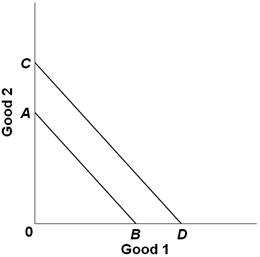
53. Refer to the above graph. The shift of the budget line from AB to CD is consistent with:
A. a decrease in money income.
B. an increase in money income.
C. an increase in the price of Good 1.
D. a decrease in the price of Good 2.
AACSB: Analytic
Bloom's: Application
Learning Objective: 1-4
Level: Moderate
Topic: Individual's economic problem
54. Refer to the above graph. The shift of the budget line from CD to AB is consistent with:
A. a decrease in money income.
B. an increase in money income.
C. an increase in the price of Good 1.
D. a decrease in the price of Good 2.
AACSB: Analytic
Bloom's: Application
Learning Objective: 1-4
Level: Moderate
Topic: Individual's economic problem
55. In the diagram above, Cheri's budget line shifts outward from AB to CD. Which statement below is consistent with this shift?
A. Both prices double; her income doubles.
B. Her income is reduced; no change in either price.
C. Both prices are reduced by 50 percent; her income is reduced by less than 50 percent.
D. Both the price of good 1 and Cheri's income increase; there is no change in price for good 2.
AACSB: Analytic
Bloom's: Application
Learning Objective: 1-4
Level: Moderate
Topic: Individual's economic problem
Answer the next question(s) using the following figure:
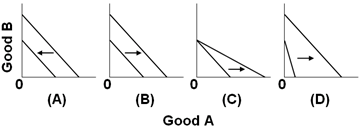
56. Refer to the above graph. Which pairs of budget constraints represent only an increase in income, but no change in the price of A and B?
A. graph A
B. graph B
C. graph C
D. graph D
AACSB: Analytic
Bloom's: Application
Learning Objective: 1-4
Level: Moderate
Topic: Individual's economic problem
57. Refer to the above graph. Which pairs of budget constraints represent only a decrease in the price of Good A, but no change in income?
A. graph A
B. graph B
C. graph C
D. graph D
AACSB: Analytic
Bloom's: Application
Learning Objective: 1-4
Level: Moderate
Topic: Individual's economic problem
Answer the next question using the following figure:

58. In the graph above, A is the initial budget line and B is the new budget line. Which of the following changes might have occurred?
A. P1 was unchanged, P2 increased, income decreased
B. P1 decreased, P2 increased, income was unchanged
C. P1 increased, P2 decreased, income was unchanged
D. P1 decreased, P2 was unchanged, income increased
AACSB: Analytic
Bloom's: Application
Learning Objective: 1-4
Level: Difficult
Topic: Individual's economic problem
Answer the next question(s) using the following figures:
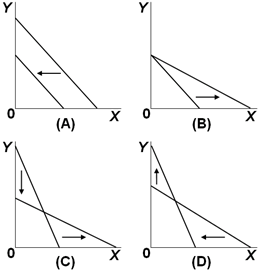
59. Refer to the above graph. Which pairs of budget constraints represent only a decrease in income, but no change in the price of X and Y?
A. graph A
B. graph B
C. graph C
D. graph D
AACSB: Analytic
Bloom's: Application
Learning Objective: 1-4
Level: Moderate
Topic: Individual's economic problem
60. Refer to the above graph. Which pairs of budget constraints represent only a decrease in the price of X, but no change in income and no change in the price of Y?
A. graph A
B. graph B
C. graph C
D. graph D
AACSB: Analytic
Bloom's: Application
Learning Objective: 1-4
Level: Moderate
Topic: Individual's economic problem
61. Refer to the above graphs. Which of the above budget constraint lines illustrates a decrease in the price of good X and an increase in the price of good Y?
A. graph A
B. graph B
C. graph C
D. graph D
AACSB: Analytic
Bloom's: Application
Learning Objective: 1-4
Level: Moderate
Topic: Individual's economic problem
Answer the next question using the following figures:
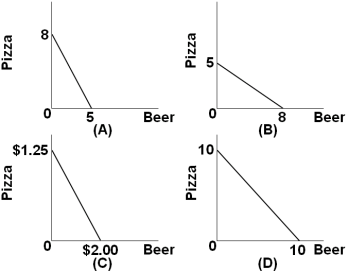
62. Refer to the above graphs. Pizza and beer are the only two goods Jon consumes. The price of beer is $2.00 per pitcher and pizza is $1.25 per slice. If Jon has only $10 to spend for the evening, which graph represents the set of possible combinations of beer and pizza he can consume?
A. graph A
B. graph B
C. graph C
D. graph D
AACSB: Analytic
Bloom's: Application
Learning Objective: 1-4
Level: Difficult
Topic: Individual's economic problem
63. The individual who brings together economic resources and assumes the risk in a capitalist economy is called the:
A. manager.
B. entrepreneur.
C. stockbroker.
D. banker.
AACSB: Analytic
Bloom's: Knowledge
Learning Objective: 1-4
Level: Easy
Topic: Society's economic problem
64. Which would not be considered as capital (or an economic resource) by an economist?
A. a share of corporate stock issued by General Motors
B. an automobile used by General Electric
C. a crane used by a building contractor
D. a razor used by a barber
AACSB: Analytic
Bloom's: Knowledge
Learning Objective: 1-4
Level: Difficult
Topic: Society's economic problem
65. Which is not considered to be an economic resource?
A. land (or natural resources)
B. money
C. labor
D. tools and machinery
AACSB: Analytic
Bloom's: Knowledge
Learning Objective: 1-4
Level: Easy
Topic: Society's economic problem
66. Economic resources in the capitalist system are brought together by:
A. government units.
B. entrepreneurs.
C. corporate shareholders.
D. the managerial elite.
AACSB: Analytic
Bloom's: Knowledge
Learning Objective: 1-4
Level: Difficult
Topic: Society's economic problem
67. Money is not considered to be an economic resource because:
A. as such it is not productive.
B. money is not a free gift of nature.
C. the terms of trade can be determined in nonmonetary terms.
D. idle money balances do not earn interest income.
AACSB: Analytic
Bloom's: Knowledge
Learning Objective: 1-4
Level: Moderate
Topic: Society's economic problem
68. Which is a factor of production?
A. money
B. interest
C. rent
D. capital
AACSB: Analytic
Bloom's: Knowledge
Learning Objective: 1-4
Level: Easy
Topic: Society's economic problem
69. Which is considered to be an economic resource by economists?
A. rent
B. money
C. labor
D. wages
AACSB: Analytic
Bloom's: Knowledge
Learning Objective: 1-4
Level: Easy
Topic: Society's economic problem
70. Society wants to use its scarce resources efficiently. To achieve this economic goal it must:
A. have full employment and full production.
B. have a fixed resource base and fixed technology.
C. expand the use of capital goods and reduce the use of labor.
D. increase the rental, interest, wage, and profit payments to the factors of production.
AACSB: Analytic
Bloom's: Knowledge
Learning Objective: 1-5
Level: Moderate
Topic: Production possibility model
71. When an economy is at full employment and full production, more of any one product:
A. cannot be produced because there is full production.
B. can be produced only if there is a general decrease in prices.
C. can be produced only if there is less production of some other products.
D. cannot be produced unless private enterprise does so rather than government.
AACSB: Analytic
Bloom's: Knowledge
Learning Objective: 1-5
Level: Moderate
Topic: Production possibility model
72. The production possibilities curve represents which of the following?
A. the amount of goods attainable with variable resources
B. the maximum amount of goods attainable with variable resources
C. maximum combinations of goods attainable with fixed resources
D. the amount of goods attainable if prices decline
AACSB: Analytic
Bloom's: Knowledge
Learning Objective: 1-5
Level: Difficult
Topic: Production possibility model
73. On a production possibilities curve, the single optimal or best combination of output for any society:
A. is at a point near the top of the curve.
B. is at the precise midpoint of the curve.
C. is at a point near the bottom of the curve.
D. depends upon the preferences of society.
AACSB: Analytic
Bloom's: Knowledge
Learning Objective: 1-5
Level: Easy
Topic: Production possibility model
Use the table to complete the following question(s).
The following economy produces two products.

74. Refer to the above table. The total opportunity cost of the three units of steel is:
A. 15 units of wheat.
B. 20 units of wheat.
C. 45 units of wheat.
D. 55 units of wheat.
AACSB: Analytic
Bloom's: Application
Learning Objective: 1-5
Level: Moderate
Topic: Production possibility model
75. Refer to the above table. The marginal opportunity cost of the third unit of steel is:
A. 10 units of wheat.
B. 15 units of wheat.
C. 20 units of wheat.
D. 30 units of wheat.
AACSB: Analytic
Bloom's: Application
Learning Objective: 1-5
Level: Moderate
Topic: Production possibility model
76. Refer to the above table. A change from possibility C to B means that:
A. 1 unit of steel is given up to get 75 units of wheat.
B. 2 units of steel are given up to get 75 units of wheat.
C. 1 unit of steel is given up to get 15 more units of wheat.
D. 2 units of steel are given up to get 15 more units of wheat.
AACSB: Analytic
Bloom's: Application
Learning Objective: 1-5
Level: Easy
Topic: Production possibility model
77. Refer to the above table. In moving from possibility A to F, the cost of a unit of steel in terms of a unit of wheat:
A. increases.
B. decreases.
C. remains constant.
D. increases from A to B, and decreases from B to F.
AACSB: Analytic
Bloom's: Application
Learning Objective: 1-5
Level: Easy
Topic: Production possibility model
Use the table to complete the following question(s).
The following economy produces two products.

78. Refer to the above table. The total opportunity cost of the three units of tanks is:
A. 200 units of autos.
B. 350 units of autos.
C. 650 units of autos.
D. 1000 units of autos.
AACSB: Analytic
Bloom's: Application
Learning Objective: 1-5
Level: Moderate
Topic: Production possibility model
79. Refer to the above table. The marginal opportunity cost of the fourth unit of tanks is:
A. 200.
B. 300.
C. 350.
D. 650.
AACSB: Analytic
Bloom's: Application
Learning Objective: 1-5
Level: Moderate
Topic: Production possibility model
80. Refer to the above table. The opportunity cost of each additional tank in terms of autos:
A. remains constant.
B. falls as more tanks are produced.
C. increases as more tanks are produced.
D. cannot be measured because there is no currency.
AACSB: Analytic
Bloom's: Application
Learning Objective: 1-5
Level: Moderate
Topic: Production possibility model
81. Refer to the above table. According to the production possibilities schedule, a combination of four tanks and 650 autos is:
A. attainable, but involves an efficient use of society's resources.
B. attainable, but would not be in the best interests of a strong national defense.
C. not attainable because it is not listed in the schedule.
D. not attainable because society does not have sufficient resources to produce this combination.
AACSB: Analytic
Bloom's: Application
Learning Objective: 1-5
Level: Moderate
Topic: Production possibility model
82. Given the production possibilities schedule above, a combination of three tanks and 350 autos:
A. illustrates the tradeoff between tanks and autos.
B. is attainable but involves the unemployment or inefficient use of some of society's resources.
C. cannot be produced by society, given its current
D. Level of resources and production technology.
E. is not attainable because this combination is not listed in the schedule.
AACSB: Analytic
Bloom's: Application
Learning Objective: 1-5
Level: Difficult
Topic: Production possibility model
Use the graph below to complete the following question(s).
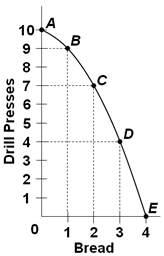
83. Refer to the above graph. The total opportunity cost of nine drill presses is:
A. 1 unit of bread.
B. 2 units of bread.
C. 3 units of bread.
D. 4 units of bread.
AACSB: Analytic
Bloom's: Application
Learning Objective: 1-5
Level: Moderate
Topic: Production possibility model
84. Refer to the above graph. The marginal opportunity cost of the fourth unit of bread is:
A. 1 unit of drill presses.
B. 2 units of drill presses.
C. 3 units of drill presses.
D. 4 units of drill presses.
AACSB: Analytic
Bloom's: Application
Learning Objective: 1-5
Level: Moderate
Topic: Production possibility model
85. A point inside the production possibilities curve is:
A. attainable and the economy is efficient.
B. attainable, but the economy is inefficient.
C. unattainable, but the economy is inefficient.
D. unattainable and the economy is efficient.
AACSB: Analytic
Bloom's: Knowledge
Learning Objective: 1-5
Level: Moderate
Topic: Production possibility model
86. A point on the frontier of the production possibilities curve is:
A. attainable and the economy is efficient.
B. attainable, but the economy is inefficient.
C. unattainable, but the economy is inefficient.
D. unattainable and the economy is efficient.
AACSB: Analytic
Bloom's: Knowledge
Learning Objective: 1-5
Level: Moderate
Topic: Production possibility model
87. The production possibility curve:
A. is convex to the origin.
B. is based on the law of diminishing returns.
C. is the boundary between attainable and unattainable outputs.
D. reflects the mixed economy found with most economic systems.
AACSB: Analytic
Bloom's: Knowledge
Learning Objective: 1-5
Level: Difficult
Topic: Production possibility model
88. A movement along the production possibilities curve would imply that:
A. the labor force has grown.
B. productivity has increased.
C. productivity has declined.
D. society has chosen a different set of outputs.
AACSB: Analytic
Bloom's: Knowledge
Learning Objective: 1-5
Level: Easy
Topic: Production possibility model
89. If an economy is producing at a point inside a production possibilities curve:
A. the economy is efficient.
B. there is economic growth.
C. resources are unemployed.
D. resources are fully employed.
AACSB: Analytic
Bloom's: Knowledge
Learning Objective: 1-5
Level: Moderate
Topic: Production possibility model
Use the graph below to complete the following question.
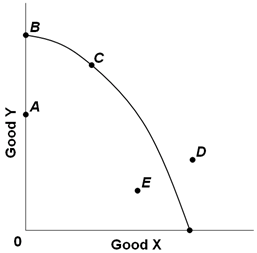
90. The graph above shows the production possibilities curve for an economy producing two goods, X and Y. Which of the points on the graph indicate unemployed resources?
A. D only
B. E only
C. E and A only
D. B and C only
AACSB: Analytic
Bloom's: Application
Learning Objective: 1-5
Level: Easy
Topic: Production possibility model
91. If an economy that produces capital and consumer goods is operating at a point on its production possibilities curve, this indicates that:
A. it is achieving full employment but not full production.
B. it is achieving full production but not full employment.
C. more capital goods can be produced only at the cost of some consumer goods.
D. the economy is incapable of achieving significant economic growth.
AACSB: Analytic
Bloom's: Knowledge
Learning Objective: 1-5
Level: Difficult
Topic: Production possibility model
92. Consider a society that is producing inside its production possibilities frontier. This society could best achieve efficiency in its production of output by:
A. distributing incomes more equally.
B. fully employing all available resources.
C. increasing the levels of wages and prices.
D. producing relatively more capital goods and relatively fewer consumer goods.
AACSB: Analytic
Bloom's: Knowledge
Learning Objective: 1-5
Level: Difficult
Topic: Production possibility model
93. A reduction in the level of unemployment would have which effect with respect to the nation's production possibilities curve?
A. It would shift the curve to the right.
B. It would shift the curve to the left.
C. It would not shift the curve; it would be represented by moving from a point inside the curve toward the curve.
D. It would not shift the curve; it would be represented by moving from a point on the curve to a point to the right of the curve.
AACSB: Analytic
Bloom's: Knowledge
Learning Objective: 1-5
Level: Difficult
Topic: Production possibility model
Use the graph below to complete the following question(s).
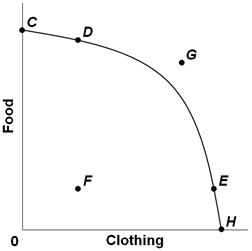
94. Points C, D, E, and H on the above graph show:
A. an inefficient allocation of society's scarce resources.
B. a constant tradeoff between food and clothing.
C. possible combinations of food and clothing.
D. unattainable combinations of food and clothing.
AACSB: Analytic
Bloom's: Application
Learning Objective: 1-5
Level: Easy
Topic: Production possibility model
95. The combination of food and clothing shown by point G on the above graph:
A. is not attainable, given society's available resources and technology.
B. can be attained only if some of society's resources are unemployed.
C. suggests that the law of increasing relative costs is not relevant in this case.
D. results only because society allocates its resources inefficiently.
AACSB: Analytic
Bloom's: Application
Learning Objective: 1-5
Level: Moderate
Topic: Production possibility model
96. Along a production possibilities curve, an increase in the production of one type of good can be accomplished only by:
A. decreasing the production of the other type of good.
B. increasing the production of the other type of good.
C. holding constant the production of the other type of good.
D. decreasing the price of the other type of good.
AACSB: Analytic
Bloom's: Knowledge
Learning Objective: 1-5
Level: Easy
Topic: Production possibility model
97. Assume that for Indy, one hour of study time in economics is perfectly substitutable for an hour of study time in calculus. Indy has exams in both subjects tomorrow and he determines that if spends all of his time studying economics, he will receive scores of 96 on his economics exam and 45 on his calculus exam. If he studies only calculus, his econ score will be 81 and his calculus score 90. Based on this information and assuming that Indy has no better alternative use of his time, what is the opportunity cost of improving his econ score by one (1) point?
A. 1 point on his calculus exam.
B. 1/3 point on his calculus exam.
C. 3 points on his calculus exam.
D. The opportunity cost cannot be determined with the information given.
AACSB: Analytic
Bloom's: Application
Learning Objective: 1-5
Level: Moderate
Topic: Production possibility model
98. If a production possibilities boundary is a concave curve and not a straight line, then:
A. resources are equally suited to producing alternative products.
B. resources are not equally suited to producing alternative products.
C. resources are perfectly interchangeable to alternative uses.
D. there are unemployed resources.
AACSB: Analytic
Bloom's: Knowledge
Learning Objective: 1-5
Level: Moderate
Topic: Production possibility model
99. If economic resources are perfectly shiftable between the two products shown on a production possibilities graph:
A. the economy will always be at full employment.
B. more of one product can be produced without producing less of the other product.
C. the production possibilities curve would be a straight line.
D. the two products are of equal value to the economy.
AACSB: Analytic
Bloom's: Knowledge
Learning Objective: 1-5
Level: Difficult
Topic: Production possibility model
100. The production possibilities curve bows outward from the origin because:
A. opportunity costs decrease as the production of a good increases.
B. opportunity costs increase as the production of a good increases.
C. more production of one good results in more production of the other good.
D. resources are of uniform quality.
AACSB: Analytic
Bloom's: Knowledge
Learning Objective: 1-5
Level: Moderate
Topic: Production possibility model
101. The law of increasing opportunity costs indicates that:
A. resources are perfectly mobile except for transportation costs.
B. the sum of all costs cannot rise above the market price of a product.
C. to produce more of one good, society must sacrifice larger and larger amounts of alternative goods.
D. if the prices of all the resources involved in the production of goods increase, the cost of producing those goods will increase at the same rate.
AACSB: Analytic
Bloom's: Knowledge
Learning Objective: 1-5
Level: Difficult
Topic: Production possibility model
Use the table below to complete the following questions.
The production possibilities curve below shows the hypothetical relationship between the production of capital goods and consumer goods in an economy.

102. Refer to the table above. What is the opportunity cost of producing the third unit of capital goods?
A. 4 units of consumer goods
B. 5 units of consumer goods
C. 6 units of consumer goods
D. 7 units of consumer goods
AACSB: Analytic
Bloom's: Application
Learning Objective: 1-5
Level: Difficult
Topic: Production possibility model
103. Refer to the table above. What is the opportunity cost of producing the first two units of capital goods?
A. 4 units of consumer goods
B. 5 units of consumer goods
C. 9 units of consumer goods
D. 13 units of consumer goods
AACSB: Analytic
Bloom's: Application
Learning Objective: 1-5
Level: Moderate
Topic: Production possibility model
104. Refer to the table above. What is the opportunity cost of producing the first three units of capital goods?
A. 6 units of consumer goods
B. 7 units of consumer goods
C. 15 units of consumer goods
D. 22 units of consumer goods
AACSB: Analytic
Bloom's: Application
Learning Objective: 1-5
Level: Moderate
Topic: Production possibility model
105. The law of increasing opportunity cost explains why the shape of the production possibilities curve is:
A. a straight line parallel to the horizontal axis.
B. a straight line from one axis to the other.
C. bowed out from the origin of the graph.
D. bowed toward the origin of the graph.
AACSB: Analytic
Bloom's: Knowledge
Learning Objective: 1-5
Level: Moderate
Topic: Production possibility model
106. Which statement is an economic rationale for the law of increasing opportunity cost?
A. The economy is employing all of its available resources.
B. Many economic resources are better at producing one product than another.
C. In any economy, the state of technology is changing and resources are variable.
D. The economy is achieving productive efficiency by producing goods and services at the least cost.
AACSB: Analytic
Bloom's: Knowledge
Learning Objective: 1-5
Level: Moderate
Topic: Production possibility model
107. Opportunity cost is best defined as:
A. marginal cost minus marginal benefit.
B. the value of the best foregone alternative.
C. the time spent on an economic activity.
D. the money cost of an economic decision.
AACSB: Analytic
Bloom's: Knowledge
Learning Objective: 1-5
Level: Difficult
Topic: Production possibility model
108. Tammie makes $150 a day as a bank clerk. She takes off two days of work without pay to fly to another city to attend the concert of her favorite music group. The cost of transportation for the trip is $250. The cost of the concert ticket is $50. The opportunity cost of Tammie's trip to the concert is:
A. $300.
B. $450.
C. $500.
D. $600.
AACSB: Analytic
Bloom's: Application
Learning Objective: 1-5
Level: Difficult
Topic: Production possibility model
109. When a state government chooses to build more roads, the required resources are no longer available for spending on public education. This dilemma illustrates the concept of:
A. marginal analysis.
B. full employment.
C. full production.
D. opportunity cost.
AACSB: Analytic
Bloom's: Knowledge
Learning Objective: 1-5
Level: Moderate
Topic: Production possibility model
110. The opportunity cost of a new national park is the:
A. alternative uses for the land and funding for the park.
B. cost of constructing park buildings and highways to get to it.
C. cost of hiring staff and park rangers to provide services for visitors.
D. increased pollution to the wildlife habitat at the park.
AACSB: Analytic
Bloom's: Application
Learning Objective: 1-5
Level: Easy
Topic: Production possibility model
111. After graduating from high school, Ron Willis plans to go to college. The college tuition is $15,000 a year. But, instead of going to college, Ron could take a full-time job paying $20,000. If Ron decides to go to college, what is his opportunity cost for attending for one year?
A. $5,000
B. $15,000
C. $20,000
D. $35,000
AACSB: Analytic
Bloom's: Application
Learning Objective: 1-5
Level: Moderate
Topic: Production possibility model
112. In a production possibilities table, the most-valued or optimal point for society is determined by:
A. a combination of products at the midpoint of the table.
B. a combination of products at the ends of the table.
C. the equality of marginal benefits and marginal costs.
D. the maximization of opportunity costs.
AACSB: Analytic
Bloom's: Knowledge
Learning Objective: 1-5
Level: Difficult
Topic: Production possibility model
113. The overallocation of resources by society to the production of a product means that the:
A. marginal benefit is greater than the marginal cost.
B. marginal cost is greater than the marginal benefit.
C. entrepreneurs are making too much profit in the economy.
D. workers are not being paid adequate wages and salaries.
AACSB: Analytic
Bloom's: Knowledge
Learning Objective: 1-5
Level: Moderate
Topic: Production possibility model
114. When society overallocates resources to the production of a product it means that the:
A. investment in the product is declining.
B. opportunity cost of the product is decreasing.
C. marginal benefit is greater than the marginal cost.
D. marginal benefit is less than the marginal cost.
AACSB: Analytic
Bloom's: Knowledge
Learning Objective: 1-5
Level: Difficult
Topic: Production possibility model
115. The "war on terror" waged by the United States:
A. Shifted the production possibilities curve to the right.
B. Shifted the production possibilities curve inward.
C. Caused the U.S. to shift from "defense goods" to "civilian goods."
D. Caused the perceived marginal benefit curve for "defense goods" to shift out.
AACSB: Analytic
Bloom's: Knowledge
Learning Objective: 1-5
Level: Moderate
Topic: Economics; economic perspectives
116. Scaling back the U.S. "war on terror" would:
A. Shift U.S. production from "defense goods" to "civilian goods."
B. Shift U.S. production from "civilian goods" to "defense goods."
C. Shift the production possibilities curve inward.
D. Suggest that we were allocating less than the optimal amount of resources to the war on terror.
AACSB: Analytic
Bloom's: Knowledge
Learning Objective: 1-5
Level: Moderate
Topic: Economics; economic perspectives
117. Economic growth may be represented by a:
A. rightward shift of the production possibilities curve.
B. leftward shift of the production possibilities curve.
C. production possibilities curve which remains fixed.
D. point outside (to the right) of the production possibilities curve.
AACSB: Analytic
Bloom's: Knowledge
Learning Objective: 1-5
Level: Easy
Topic: Unemployment, growth, and the future
118. Increases in resources or improvements in technology will tend to cause a society's production possibilities curve to:
A. shift inward or to the left.
B. shift outward or to the right.
C. become horizontal.
D. become vertical.
AACSB: Analytic
Bloom's: Knowledge
Learning Objective: 1-5
Level: Easy
Topic: Unemployment, growth, and the future
119. A nation that devotes more of its resources to capital investment is likely to:
A. shift outward its production possibilities curve.
B. shift inward its production possibilities curve.
C. increase the slope of its production possibilities curve.
D. decrease the slope of its production possibilities curve.
AACSB: Analytic
Bloom's: Knowledge
Learning Objective: 1-5
Level: Easy
Topic: Unemployment, growth, and the future
120. All of the following would affect the position of a country's production possibilities curve, except:
A. the quantity of labor.
B. the level of unemployment.
C. the amount of the capital stock.
D. technological progress.
AACSB: Analytic
Bloom's: Knowledge
Learning Objective: 1-5
Level: Difficult
Topic: Unemployment, growth, and the future
Use the graph below to answer the following question(s).
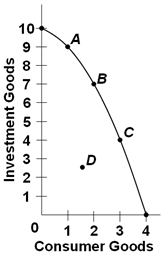
121. Refer to the above graph. Which point on the production possibilities curve would indicate that there is unemployment in this economy?
A. A
B. B
C. C
D. D
AACSB: Analytic
Bloom's: Application
Learning Objective: 1-5
Level: Easy
Topic: Unemployment, growth, and the future
122. Refer to the above graph. The selection of which point on the production possibilities curve is most like to result in the largest increase in economic growth over time?
A. A
B. B
C. C
D. D
AACSB: Analytic
Bloom's: Application
Learning Objective: 1-5
Level: Moderate
Topic: Unemployment, growth, and the future
Use the graph below to answer the following question.
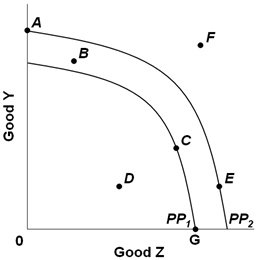
123. The graph above shows two production possibilities curves for a nation which produces two goods, Y and Z. PP1 and PP2 show the production possibilities for years 1 and 2. The nation's total production then decreased after year 2. This change could be represented by a move from:
A. F to A.
B. A to E.
C. F to B.
D. E to D.
AACSB: Analytic
Bloom's: Application
Learning Objective: 1-5
Level: Easy
Topic: Unemployment, growth, and the future
Use the graph below to answer the following question(s).
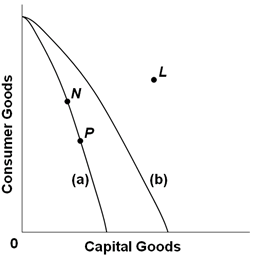
124. Refer to the above production possibilities curves. Curve (a) is the current curve for the economy. Given production possibilities curve (a), point N suggests that the economy is:
A. attaining full employment but not full production.
B. attaining full production but not full employment.
C. using its available resources inefficiently.
D. attaining both full employment and full production.
AACSB: Analytic
Bloom's: Application
Learning Objective: 1-5
Level: Easy
Topic: Unemployment, growth, and the future
125. Refer to the above production possibilities curves. Curve (a) is the current curve for the economy. The movement from curve (a) to curve (b) suggests:
A. a movement from unemployment to full employment.
B. an improvement in capital goods technology but not in consumer goods technology.
C. an improvement in consumer goods technology but not in capital goods technology.
D. a decline in the total output of this society.
AACSB: Analytic
Bloom's: Application
Learning Objective: 1-5
Level: Moderate
Topic: Unemployment, growth, and the future
126. Refer to the above production possibilities curves. Curve (a) is the current curve for the economy. Other things being equal, society's current choice of point P on curve (a) will:
A. allow it to achieve more rapid economic growth than would the choice of point N.
B. entail a slower rate of economic growth than would the choice of point N.
C. entail the same rate of growth as would the choice of point N.
D. be unobtainable because it exceeds the productive capacity of the economy.
AACSB: Analytic
Bloom's: Application
Learning Objective: 1-5
Level: Difficult
Topic: Unemployment, growth, and the future
127. Which situation would most likely shift the production possibilities curve for a nation in an outward direction?
A. a decrease in the quality of products
B. an increase in the supply of resources
C. a decrease in the state of technology
D. an increase in the amount of discrimination
AACSB: Analytic
Bloom's: Knowledge
Learning Objective: 1-5
Level: Moderate
Topic: Unemployment, growth, and the future
128. Suppose there are two economies, Alpha and Beta, which have the same production possibilities curves and are on the same point on each curve. If Beta then devotes more resources to investment goods than consumer goods when compared to Alpha, then in the future:
A. Alpha will experience greater economic growth than Beta.
B. Beta will experience greater economic growth than Alpha.
C. Alpha will not be able to achieve full employment or productive efficiency.
D. Beta will not be able to achieve full employment or productive efficiency
AACSB: Analytic
Bloom's: Knowledge
Learning Objective: 1-5
Level: Moderate
Topic: Unemployment, growth, and the future
129. Cuba is a command economy that suffered decline in economic growth because of a cut in support from the former Soviet Union when it collapsed. As a consequence, Cuba:
A. experienced a shift outward in its production possibilities curve.
B. experienced a shift inward in its production possibilities curve.
C. moved along its existing production possibilities curve.
D. went to a point inside its production possibilities curve.
AACSB: Analytic
Bloom's: Knowledge
Learning Objective: 1-5
Level: Moderate
Topic: Unemployment, growth, and the future
130. Which situation would most likely cause a nation's production possibilities curve to shift inward?
A. the construction of more capital goods
B. an increase in discrimination based on race
C. an increase in the number of skilled immigrant workers
D. the destruction from bombing and warfare in a losing military conflict
AACSB: Analytic
Bloom's: Knowledge
Learning Objective: 1-5
Level: Easy
Topic: Unemployment, growth, and the future
131. A nation can increase its production possibilities by:
A. shifting resources from investment good production to consumer good production.
B. shifting resources from private goods to public goods.
C. improving labor productivity.
D. eliminating discrimination.
AACSB: Analytic
Bloom's: Knowledge
Learning Objective: 1-5
Level: Moderate
Topic: Unemployment, growth, and the future
Use the graph below to answer the following question.
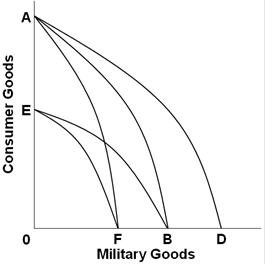
132. Refer to the above graph. Assume that before the Persian Gulf War, Iraq's production possibilities were represented by AB. Which line on the above graph would represent the change in Iraq's production possibilities after the war?
A. AB to BE
B. AB to AF
C. AB to AD
D. AB to EF
AACSB: Analytic
Bloom's: Application
Learning Objective: 1-5
Level: Difficult
Topic: Unemployment, growth, and the future
True / False Questions
133. Economics is the study of the efficient use of scarce resources to achieve maximum satisfaction of economic wants.
TRUE
AACSB: Analytic
Bloom's: Knowledge
Learning Objective: 1-1
Level: Easy
Topic: Economics; economic perspective
134. Marginal analysis is the comparison of additional benefits with the additional costs.
TRUE
AACSB: Analytic
Bloom's: Knowledge
Learning Objective: 1-1
Level: Easy
Topic: Economics; economic perspective
135. From the "economic perspective" people make purposeful decisions based on hypotheses.
FALSE
AACSB: Analytic
Bloom's: Knowledge
Learning Objective: 1-1
Level: Difficult
Topic: Economics; economic perspective
136. Economics is primarily concerned with marginal changes from the status quo.
TRUE
AACSB: Analytic
Bloom's: Knowledge
Learning Objective: 1-1
Level: Moderate
Topic: Economics; economic perspective
137. The scientific method involves developing hypotheses from factual observations, and then testing the hypotheses.
TRUE
AACSB: Analytic
Bloom's: Knowledge
Learning Objective: 1-2
Level: Difficult
Topic: Theories, principles and models
138. By using the same ceteris paribus assumptions, economic principles are just as certain and precise as those of the laboratory sciences.
FALSE
AACSB: Analytic
Bloom's: Knowledge
Learning Objective: 1-2
Level: Moderate
Topic: Theories, principles and models
139. Macroeconomics is concerned with the whole economy or its major sectors.
TRUE
AACSB: Analytic
Bloom's: Knowledge
Learning Objective: 1-3
Level: Easy
Topic: Macroeconomics and microeconomics
140. The economizing problem arises from the conflict between having relatively unlimited resources and relatively limited wants.
FALSE
AACSB: Analytic
Bloom's: Knowledge
Learning Objective: 1-4
Level: Easy
Topic: Society's economic problem
141. The fundamental economic problem is that productive resources are scarce in relation to the demand for them.
TRUE
AACSB: Analytic
Bloom's: Knowledge
Learning Objective: 1-4
Level: Moderate
Topic: Society's economic problem
142. The four factors of production are land, labor, capital, and government services.
FALSE
AACSB: Analytic
Bloom's: Knowledge
Learning Objective: 1-4
Level: Easy
Topic: Society's economic problem
143. A point inside the production possibilities curve illustrates that resources are not being used as efficiently as possible.
TRUE
AACSB: Analytic
Bloom's: Knowledge
Learning Objective: 1-4
Level: Easy
Topic: Production possibilities model
144. The concave, or bowed-out, shape of the production possibilities curve illustrates the law of increasing opportunity costs.
TRUE
AACSB: Analytic
Bloom's: Knowledge
Learning Objective: 1-4
Level: Difficult
Topic: Production possibilities model
145. If the marginal benefits are greater than the marginal cost of an activity, then society is overallocating resources to this activity.
FALSE
AACSB: Analytic
Bloom's: Knowledge
Learning Objective: 1-4
Level: Moderate
Topic: Production possibilities model
146. The marginal cost curve for a product slopes upward as more units are produced because of the law of increasing costs.
TRUE
AACSB: Analytic
Bloom's: Knowledge
Learning Objective: 1-4
Level: Difficult
Topic: Production possibilities model
147. If the marginal benefits of the output from resources devoted to the production of a product are greater than the marginal costs, then there has been an overallocation of resources to the production of that product.
FALSE
AACSB: Analytic
Bloom's: Knowledge
Learning Objective: 1-4
Level: Difficult
Topic: Production possibilities model
148. Economic growth is shown by a shift of the production possibilities curve outward and to the right.
TRUE
AACSB: Analytic
Bloom's: Knowledge
Learning Objective: 1-5
Level: Easy
Topic: Unemployment, growth, and the future
149. If a nation is incurring a trade deficit (it is buying more from abroad - importing, then it is selling abroad - exporting), then it is most likely producing beyond the frontier of its production possibilities curve.
FALSE
AACSB: Analytic
Bloom's: Knowledge
Learning Objective: 1-5
Level: Difficult
Topic: Unemployment, growth, and the future
150. The implied production possibilities curve between work time and grades suggests that more hours spent working will mean more income, but also less study time and a lower grade average.
TRUE
AACSB: Analytic
Bloom's: Knowledge
Learning Objective: 1-5
Level: Moderate
Topic: Unemployment, growth, and the future
Source: http://www.ateneonline.it/brue/isbn6683-4_01_TB.doc
Web site to visit: http://www.ateneonline.it/
Author of the text: indicated on the source document of the above text
If you are the author of the text above and you not agree to share your knowledge for teaching, research, scholarship (for fair use as indicated in the United States copyrigh low) please send us an e-mail and we will remove your text quickly. Fair use is a limitation and exception to the exclusive right granted by copyright law to the author of a creative work. In United States copyright law, fair use is a doctrine that permits limited use of copyrighted material without acquiring permission from the rights holders. Examples of fair use include commentary, search engines, criticism, news reporting, research, teaching, library archiving and scholarship. It provides for the legal, unlicensed citation or incorporation of copyrighted material in another author's work under a four-factor balancing test. (source: http://en.wikipedia.org/wiki/Fair_use)
The information of medicine and health contained in the site are of a general nature and purpose which is purely informative and for this reason may not replace in any case, the council of a doctor or a qualified entity legally to the profession.
The following texts are the property of their respective authors and we thank them for giving us the opportunity to share for free to students, teachers and users of the Web their texts will used only for illustrative educational and scientific purposes only.
All the information in our site are given for nonprofit educational purposes
The information of medicine and health contained in the site are of a general nature and purpose which is purely informative and for this reason may not replace in any case, the council of a doctor or a qualified entity legally to the profession.
www.riassuntini.com